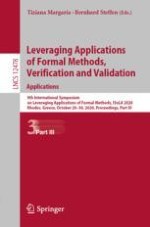The three-volume set LNCS 12476 - 12478 constitutes the refereed proceedings of the 9th International Symposium on Leveraging Applications of Formal Methods, ISoLA 2020, which was planned to take place during October 20–30, 2020, on Rhodes, Greece. The event itself was postponed to 2021 due to the COVID-19 pandemic.
The papers presented were carefully reviewed and selected for inclusion in the proceedings.
Each volume focusses on an individual topic with topical section headings within the volume:
Part I, Verification Principles:
Modularity and (De-)Composition in Verification; X-by-Construction: Correctness meets Probability; 30 Years of Statistical Model Checking; Verification and Validation of Concurrent and Distributed Systems.
Part II, Engineering Principles:
Automating Software Re-Engineering; Rigorous Engineering of Collective Adaptive Systems.
Part III, Applications:
Reliable Smart Contracts: State-of-the-art, Applications, Challenges and Future Directions; Automated Verification of Embedded Control Software; Formal methods for DIStributed COmputing in future RAILway systems.
